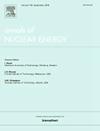Temperature flattening and thermoelectric conversion modeling of TOPAZ-II thermionic reactor
IF 1.9
3区 工程技术
Q1 NUCLEAR SCIENCE & TECHNOLOGY
引用次数: 0
Abstract
Focus on temperature non-uniformity in thermionic reactors, a code for temperature flattening is developed by taking the 100 kW TOPAZ-II thermionic reactor as an example. Two optimization schemes, central hole and fuel enrichment, were implemented. Comparison with experiments shows the model can predict temperature distribution and volt–ampere characteristics. After optimization, emitter temperature and current density are more concentrated. The maximum temperatures of central hole and enrichment schemes are reduced to 1905 K and 1940 K from 1990 K. The optimized reactor can operate at higher power density. At 2000 K emitter maximum temperature, the powers of central hole and enrichment schemes increase by 21.95% and 12.59%. A comparative study shows that increasing emitter maximum temperature from 1800 K to 2000 K can increase reactor energy conversion efficiency from 6.83% to 7.91%.

求助全文
约1分钟内获得全文
求助全文
来源期刊

Annals of Nuclear Energy
工程技术-核科学技术
CiteScore
4.30
自引率
21.10%
发文量
632
审稿时长
7.3 months
期刊介绍:
Annals of Nuclear Energy provides an international medium for the communication of original research, ideas and developments in all areas of the field of nuclear energy science and technology. Its scope embraces nuclear fuel reserves, fuel cycles and cost, materials, processing, system and component technology (fission only), design and optimization, direct conversion of nuclear energy sources, environmental control, reactor physics, heat transfer and fluid dynamics, structural analysis, fuel management, future developments, nuclear fuel and safety, nuclear aerosol, neutron physics, computer technology (both software and hardware), risk assessment, radioactive waste disposal and reactor thermal hydraulics. Papers submitted to Annals need to demonstrate a clear link to nuclear power generation/nuclear engineering. Papers which deal with pure nuclear physics, pure health physics, imaging, or attenuation and shielding properties of concretes and various geological materials are not within the scope of the journal. Also, papers that deal with policy or economics are not within the scope of the journal.
 求助内容:
求助内容: 应助结果提醒方式:
应助结果提醒方式:


